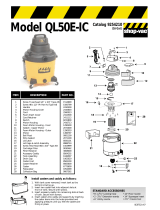
Page 8
Maintaining Tools
Keep your tool in good repair by adopting a regular maintenance pro-
gram. Before use, examine the general condition of your tool. Inspect
guards, switches, tool cord set and extension cord for damage. Check
for loose screws, misalignment, binding of moving parts, improper
mounting, broken parts and any other condition that may affect its safe
operation. If abnormal noise or vibration occurs, turn the tool off im-
mediately and have the problem corrected before further use. Do not
use a damaged tool. Tag damaged tools “DO NOT USE” until repaired
(see “Repairs”).
Under normal conditions, relubrication is not necessary until the motor
brushes need to be replaced. After six months to one year, depending on
use, return your tool to the nearest MILWAUKEE service facility for the
following:
• Lubrication
• Brush inspection and replacement
• Mechanical inspection and cleaning (gears, spindles, bearings,
housing, etc.)
• Electrical inspection (switch, cord, armature, etc.)
• Testing to assure proper mechanical and electrical operation
MAINTENANCE
Cleaning
Clean dust and debris from vents. Keep the tool handles clean, dry and
free of oil or grease. Use only mild soap and a damp cloth to clean your
tool since certain cleaning agents and solvents are harmful to plastics and
other insulated parts. Some of these include: gasoline, turpentine, lacquer
thinner, paint thinner, chlorinated cleaning solvents, ammonia and house-
hold detergents containing ammonia. Never use fl ammable or combustible
solvents around tools.
Repairs
If your tool is damaged, return the entire tool to the nearest service cen-
ter.
WARNING!
To reduce the risk of injury, always unplug your tool before per-
forming any maintenance. Never disassemble the tool or try to do
any rewiring on the tool’s electrical system. Contact a MILWAUKEE
service facility for ALL repairs.
WARNING!
To reduce the risk of injury, electric shock and damage to the tool,
never immerse your tool in liquid or allow a liquid to fl ow inside
the tool.
ACCESSORIES
To reduce the risk of injury, always unplug the tool before attach-
ing or removing accessories. Use only specifi cally recommended
accessories. Others may be hazardous.
WARNING!
FIVE YEAR TOOL LIMITED WARRANTY
For a complete listing of accessories refer to your MILWAUKEE Elec-
tric Tool catalog or go on-line to www.milwaukeetool.com. To obtain a
catalog, contact your local distributor or a service center.
Every MILWAUKEE power tool (including cordless product – tool, battery pack(s) and
battery charger and Work Lights – cordless fl ashlights) is warranted to the original
purchaser only to be free from defects in material and workmanship. Subject to
certain exceptions, MILWAUKEE will repair or replace any part on an electric power
tool which, after examination, is determined by MILWAUKEE to be defective in
material or workmanship for a period of fi ve (5) years* after the date of purchase.
Return the electric power tool and a copy of proof of purchase to a MILWAUKEE
factory Service Center location or MILWAUKEE Authorized Service Station, freight
prepaid and insured. This warranty does not apply to damage that MILWAUKEE
determines to be from repairs made or attempted by anyone other than MILWAU-
KEE authorized personnel, misuse, alterations, abuse, normal wear and tear, lack
of maintenance, or accidents.
*Every MILWAUKEE V™-technology (V18™ & V28™) LITHIUM-ION Battery Pack
and M18 XC LITHIUM-ION Battery Pack is warranted for fi ve (5) years / 2000 charges
from the date of purchase, whichever fi rst occurs. The fi rst 1000 charges or 2 years
of the warranty, whichever fi rst occurs, are covered through free replacement of the
defective battery. This means that for the earlier of the fi rst 1000 charges or two (2)
years from the date of purchase/fi rst charge, a replacement battery will be provided
to the customer for any defective battery free of charge. Thereafter, the remaining
charges up to a total of 2000 or the remainder of the fi ve (5) year period from the
date of purchase, whichever fi rst occurs, will be covered on a pro rata basis. This
means that every customer gets an additional 1000 charges or three (3) years of
pro rata warranty on the V™-technology LITHIUM-ION Battery Pack and M18 XC
LITHIUM-ION Battery Pack depending upon the amount of use.
*The warranty period for ALL other LITHIUM-ION Battery Packs is two (2) years
from the date of purchase.
*The warranty period for M12 2-Beam Laser & M12 Power Port, Ni-CD Battery
Packs, Job Site Radios, and Trade Titan™ Industrial Work Carts is one (1) year
from the date of purchase.
Warranty Registration is not necessary to obtain the applicable warranty on a MIL-
WAUKEE product. The manufacturing date of the product will be used to determine
the warranty period if no proof of purchase is provided at the time warranty service
is requested.
ACCEPTANCE OF THE EXCLUSIVE REPAIR AND REPLACEMENT REMEDIES
DESCRIBED HEREIN IS A CONDITION OF THE CONTRACT FOR THE PUR-
CHASE OF EVERY MILWAUKEE PRODUCT. IF YOU DO NOT AGREE TO THIS
CONDITION, YOU SHOULD NOT PURCHASE THE PRODUCT. IN NO EVENT
SHALL MILWAUKEE BE LIABLE FOR ANY INCIDENTAL, SPECIAL, CONSE-
QUENTIAL OR PUNITIVE DAMAGES, OR FOR ANY COSTS, ATTORNEY FEES,
EXPENSES, LOSSES OR DELAYS ALLEGED TO BE AS A CONSEQUENCE OF
ANY DAMAGE TO, FAILURE OF, OR DEFECT IN ANY PRODUCT INCLUDING,
BUT NOT LIMITED TO, ANY CLAIMS FOR LOSS OF PROFITS. THIS WARRANTY
IS EXCLUSIVE AND IN LIEU OF ALL OTHER WARRANTIES OR CONDITIONS,
WRITTEN OR ORAL, EXPRESSED OR IMPLIED. WITHOUT LIMITING THE
GENERALITY OF THE FOREGOING, MILWAUKEE DISCLAIMS ANY IMPLIED
WARRANTY OF MERCHANTABILITY OR FITNESS FOR A PARTICULAR USE
OR PURPOSE, AND ALL OTHER WARRANTIES.
This warranty applies to product sold in the U.S.A., Canada and Mexico only.
Please consult the ‘Service Center Search’ in the Parts & Service section of MILWAU-
KEE’s website www.milwaukeetool.com or call 1.800.SAWDUST (1.800.729.3878)
to locate your nearest service facility for warranty and non-warranty service on a
Milwaukee electric power tool.










